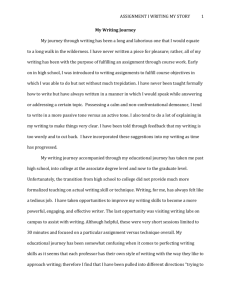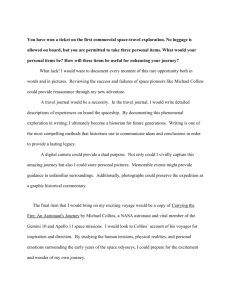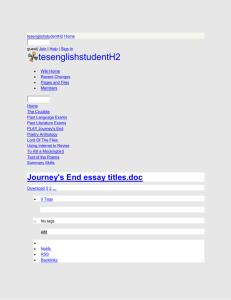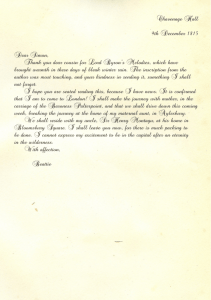FINAL FAE Summer rding
advertisement
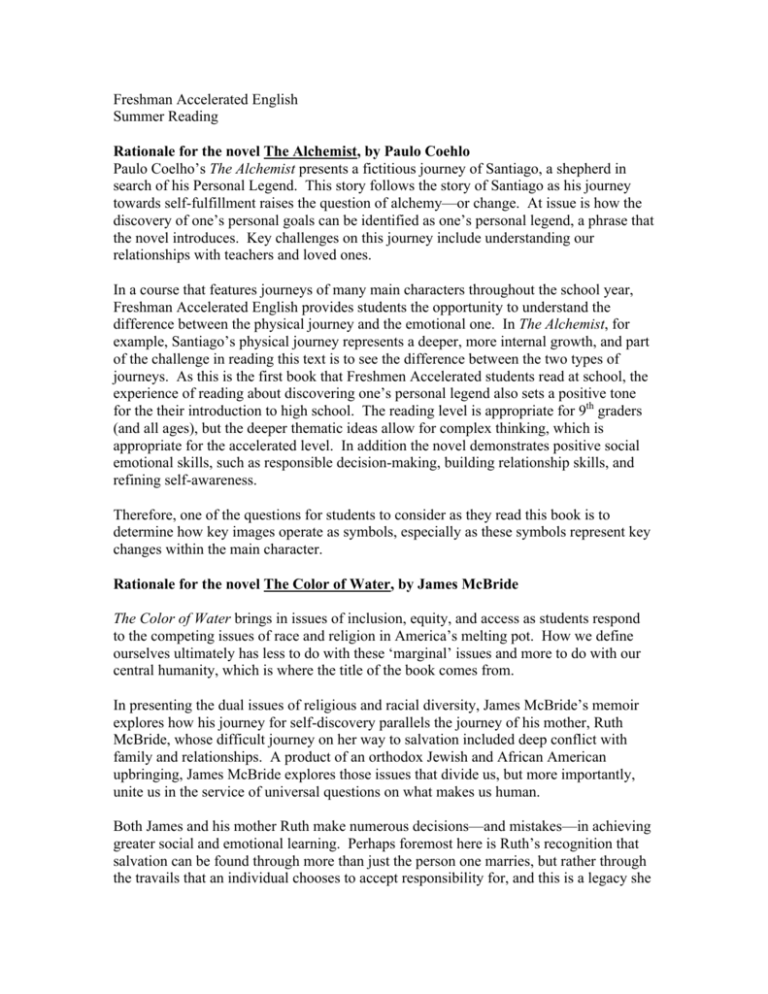
Freshman Accelerated English Summer Reading Rationale for the novel The Alchemist, by Paulo Coehlo Paulo Coelho’s The Alchemist presents a fictitious journey of Santiago, a shepherd in search of his Personal Legend. This story follows the story of Santiago as his journey towards self-fulfillment raises the question of alchemy—or change. At issue is how the discovery of one’s personal goals can be identified as one’s personal legend, a phrase that the novel introduces. Key challenges on this journey include understanding our relationships with teachers and loved ones. In a course that features journeys of many main characters throughout the school year, Freshman Accelerated English provides students the opportunity to understand the difference between the physical journey and the emotional one. In The Alchemist, for example, Santiago’s physical journey represents a deeper, more internal growth, and part of the challenge in reading this text is to see the difference between the two types of journeys. As this is the first book that Freshmen Accelerated students read at school, the experience of reading about discovering one’s personal legend also sets a positive tone for the their introduction to high school. The reading level is appropriate for 9th graders (and all ages), but the deeper thematic ideas allow for complex thinking, which is appropriate for the accelerated level. In addition the novel demonstrates positive social emotional skills, such as responsible decision-making, building relationship skills, and refining self-awareness. Therefore, one of the questions for students to consider as they read this book is to determine how key images operate as symbols, especially as these symbols represent key changes within the main character. Rationale for the novel The Color of Water, by James McBride The Color of Water brings in issues of inclusion, equity, and access as students respond to the competing issues of race and religion in America’s melting pot. How we define ourselves ultimately has less to do with these ‘marginal’ issues and more to do with our central humanity, which is where the title of the book comes from. In presenting the dual issues of religious and racial diversity, James McBride’s memoir explores how his journey for self-discovery parallels the journey of his mother, Ruth McBride, whose difficult journey on her way to salvation included deep conflict with family and relationships. A product of an orthodox Jewish and African American upbringing, James McBride explores those issues that divide us, but more importantly, unite us in the service of universal questions on what makes us human. Both James and his mother Ruth make numerous decisions—and mistakes—in achieving greater social and emotional learning. Perhaps foremost here is Ruth’s recognition that salvation can be found through more than just the person one marries, but rather through the travails that an individual chooses to accept responsibility for, and this is a legacy she gives off to James, who himself struggles to achieve a sense of identity that refrains from unhealthy dependencies upon others. By examining notions of coming of age, students are able to understand the same kinds of concerns that the youngsters in the text experience growing up. An overarching theme for the 1st semester of FAE is coming of age, so this text speaks well to this. This text also corroborates many of the same themes discovered in the 1st semester core text To Kill a Mockingbird, where issues of diversity present an historical context with relevance today. In addition to foreshadowing later texts, The Color of Water also presents an opportunity for students to understand how allusion operates in reading, as this book makes numerous references to other texts. The Color of Water also provides opportunities to explore the ways that language communicates meaning. The dual narratives of the text present a unique mixture of chronology and perspective, and comprehending the structural differences provides an awareness of how authors discover meaning through creative uses of language. Included here is an understanding of how metaphoric or symbolic language develops students’ inferential skills. The creative structure of the text—told from two points of view— coupled with the varying dialects and metaphoric language address the skills of metaphoric reading and more stylistic maturity in composition. The reading goals of this text also serve as an appropriate springboard to more challenging texts later in the Freshman Accelerated year. Purpose of Summer Reading for Freshman Accelerated English 1. To provide a common experience for all incoming ninth graders (from different schools.) 2. To provide students with both nonfiction and fiction reading analysis experience. 3. To provide a foundation for the literary and rhetorical objectives of the Accelerated / AP track. 4. To use the text The Alchemist and The Color of Water to introduce common core themes: perception, maturity, personal journey, and relationships with family and friends. 5. To establish course expectations for reading: students will engage in active reading, make inferences, and draw conclusions. 6. To introduce course expectations for writing: students will establish and sustain a clear argument, support the argument with evidence, and write with a sophisticated style. Learning Targets At the end of the unit, students will analyze a core thematic idea that emerges from the text, and write about that idea using textual evidence. Therefore, students should keep the following questions in mind during and after reading, and annotate (write down your thoughts) so you can contribute to the class discussion, and use your notes when collecting textual evidence for your writing assignment. 1. 2. 3. 4. 5. What is the significance of the journey that the characters take? What is the difference between a physical journey and an emotional journey? What role do the supporting characters play? What images can be read symbolically or metaphorically? How does the structure of the text help communicate its theme / purpose? Instructional Plan Teachers will use a variety of strategies and methods to reach the instructional goals. In the 5-7 day unit, students can expect to work in small groups and participate in wholeclass discussions about the book. In addition, students will be introduced to the foundations of independent literary analysis: thesis statement, topic sentences, principles of organization, use of citations, introduction, use of evidence. Assessment Plan Prior to instruction, students will be held accountable for their reading through a quiz designed to provide insight into their recall plot details, characters, and general thematic comprehension. During instruction, students will demonstrate emerging understanding through class discussion, small group work, and individual activities. Post-instruction, students will respond to a writing prompt in which they demonstrate their mastery of the learning targets, specifically the questions in the Learning Targets section. Feedback Students will receive feedback in the form of teacher comments during discussions and other formative activities, on their writing, and through the use of a rubric, written feedback, and/or peer review to assess writing.



